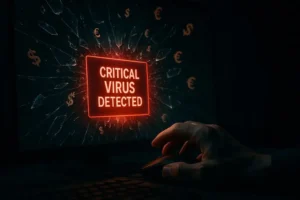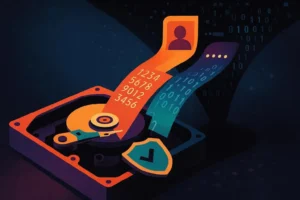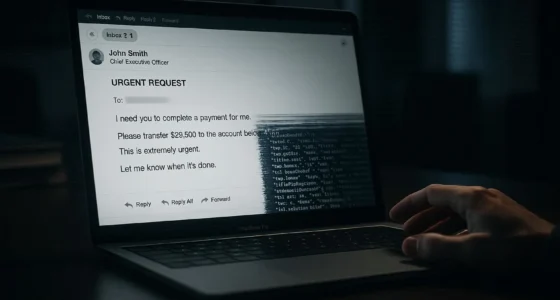At 9:47 PM, Tom Bradley’s computer screen erupted in red warnings: “CRITICAL THREAT DETECTED: 47 viruses found.” A timer counted down. “Your files will be encrypted in 5 minutes.” A button flashed: “Download Protection Now.”
Tom clicked it. The fake antivirus software was installed immediately. Within three hours, criminals had stolen $2,840 from his credit card and locked every file on his computer.
The viruses never existed. The protection was the poison. The cure was the disease.
The Perfect Digital Trap
Fake antivirus software works because it weaponizes your fear. A warning appears while you browse normal websites. Red alerts flash across your screen. Alarming messages claim your computer is infected. Timers create panic.
Your brain shuts down rational thinking. You click whatever makes the warnings stop.
That click is exactly what the predators want. It downloads real malware disguised as protection software. The program you install to save your computer actually destroys it.
Moreover, the scam feels legitimate. The warnings look professional. They use official-sounding names like “Windows Defender Pro” or “Norton Security Suite.” They display fake scan results showing hundreds of threats.
The Federal Trade Commission reports that scareware scams stole $1.5 billion from victims in 2022. That number increased 94% from 2021. The attacks are getting more sophisticated. The body count keeps rising.
How the Attack Unfolds
First, criminals compromise legitimate websites. They inject code that triggers pop-up warnings. You visit a recipe blog or news site. Suddenly your screen fills with virus alerts.
The warnings appear to come from your computer itself. They mimic Windows security notifications. They copy the design of real antivirus programs. Everything looks authentic.
Then the psychological manipulation begins. “Your computer is severely infected.” “Personal information at risk.” “Banking details compromised.” Each message escalates the threat.
Furthermore, they add time pressure. Countdown timers appear. “Act now or lose your files.” “Protection expires in 60 seconds.” Urgency prevents research.
The FBI documented that 83% of fake antivirus software victims clicked within 30 seconds of seeing the first warning. Speed is the weapon. Panic is the tool.

The Anatomy of the Scam
Jennifer Martinez, 52, ran a small accounting business from home. A virus warning appeared during tax season while she worked on client returns. The alert claimed her computer had 127 infections including ransomware.
She panicked. Client tax data was at risk. She clicked “Remove Threats Now.”
The software demanded $89.99 for a one-year license. Jennifer paid immediately. Then it requested administrator access to “complete the scan.” She granted permission.
Within minutes, the fake software had accessed her banking information. Criminals charged her credit card $327 for “additional protection services” she never authorized. They stole client information from her hard drive. They installed keyloggers to capture passwords.
Jennifer lost $4,200 total. Her clients lost trust. Two sued her for data breaches. She closed her business six months later.
The fake antivirus software destroyed her livelihood. The virus that never existed cost her everything.
The Criminal Business Model
Scareware operates on a simple formula. Scare people into downloading malware. Extract money through fake subscriptions. Steal additional data while victims believe they’re protected.
The math is brutally effective. Criminals spend $200 to compromise a popular website. That investment reaches 50,000 visitors. If 2% click the warnings, that’s 1,000 victims. At $89 per fake license, they gross $89,000.
But the real money comes from data theft. Credit card numbers. Banking credentials. Social Security numbers. Tax information. Business records.
Additionally, the fake software often installs ransomware. After convincing you it’s protecting your computer, it encrypts all your files. Then demands $500 to $5,000 for decryption.
You paid for protection. You got extortion instead.
The Internet Crime Complaint Center reports that fake antivirus software led to ransomware infections in 67% of cases. Victims paid twice—once for fake protection, again for file recovery.
The Psychology of Scareware
These scams exploit specific psychological vulnerabilities. Fear overrides logic. Urgency prevents verification. Authority triggers compliance.
The warnings use technical language that most people don’t understand. “Trojan.Win32.Generic detected.” “Critical system files corrupted.” The complexity makes it feel real.
Moreover, they trigger loss aversion. Your brain focuses on preventing loss more than achieving gain. The threat of losing your files, photos, or financial data creates desperate action.
The Federal Trade Commission found that people over 60 lost an average of $3,470 to fake antivirus software scams. Younger victims averaged $890 in losses. The elderly face more fear about technology and more assets to lose.

The Technical Devastation
Real damage begins after installation. The fake software runs constantly, slowing your computer. It displays endless false warnings to justify its existence. It blocks legitimate security programs from running.
Meanwhile, it’s stealing everything. Every password you type. Every website you visit. Every file you open. The criminals watch in real-time as you work.
Furthermore, many fake programs disable Windows updates. They prevent your computer from receiving actual security patches. This leaves your system vulnerable to real threats.
Carlos Rodriguez, 38, discovered his fake antivirus had been running for six weeks. During that time, criminals accessed his online banking daily. They made small withdrawals he didn’t notice immediately. The total reached $18,200.
His bank refused to refund the losses. The transfers appeared legitimate because they came from his own computer using his login credentials. The fake antivirus software had recorded everything.
The Subscription Trap
After the initial payment, the scam continues. Victims receive emails about subscription renewals. “Your protection expires in 24 hours.” “Renew now to stay protected.”
These emails look official. They include fake invoice numbers and customer service contacts. Many victims pay for years, believing they’re maintaining legitimate protection.
Additionally, criminals sell your credit card information to other scammers. You start seeing unauthorized charges from multiple sources. By the time you realize what happened, dozens of transactions have cleared.
The Better Business Bureau reports that fake antivirus software victims lose an average of $2,347 across multiple fraudulent transactions. The initial payment is just the beginning.
The Recovery Nightmare
Removing fake antivirus software is difficult. The programs resist deletion. They hide files deep in your system. They create multiple registry entries. They reinstall themselves after removal attempts.
Many victims pay computer repair services $150 to $400 for cleaning. Then they discover their data was already stolen. The criminals have their information forever.
Moreover, stolen credentials get sold on dark web marketplaces. Your banking login might sell for $50. Your tax information for $200. Your business records for thousands.
The Federal Trade Commission warns that fake antivirus software victims face identity theft for years after the initial scam. The attack never really ends. The data stays stolen. The vulnerability remains.
The Evolution of the Threat
Modern scareware uses sophisticated tactics. Voice warnings play through your speakers. “Your computer is infected. Call this number immediately.” The audio creates urgency that visual warnings alone can’t achieve.
Additionally, scammers now combine fake antivirus with phone scams. The warning provides a “tech support” number. You call for help. They charge $300 to “fix” the non-existent problem. Then they remotely access your computer and install more malware.
The cycle becomes endless. Each solution creates new problems. Each fix costs more money. Eventually your computer stops working entirely. Your data is gone. Your bank accounts are drained.

Recognizing the Attack
Watch for these fake antivirus software warning signs:
- Pop-ups claiming virus infections on random websites
- Countdown timers create artificial urgency
- Demands for immediate payment to fix threats
- Software you didn’t intentionally download or install
- Programs that prevent closing or exiting
- Requests for administrator access right away
- Warnings that appear before you run real antivirus scans
- Professional-looking alerts with spelling errors or strange grammar
Real antivirus programs don’t operate through pop-ups. They don’t demand immediate payment during scans. They don’t create panic with countdown timers. They run quietly in the background and notify you calmly about actual threats.
Protecting Your Computer
Never click on virus warning pop-ups that appear while browsing. Close your browser completely using Task Manager if the warnings won’t close normally. Restart your computer if necessary.
Furthermore, install legitimate antivirus software before you need it. Windows Defender comes free with Windows and provides solid protection. Paid options like Norton, McAfee, or Bitdefender offer additional features.
Run regular scans with your real antivirus program. Keep your operating system updated. Back up important files to external drives or cloud storage.
Additionally, if you accidentally install fake antivirus software, disconnect from the internet immediately. This prevents data theft while you remove the malware. Contact a legitimate computer repair service for help.
Never call phone numbers provided in virus warnings. Never grant remote access to your computer from unsolicited contacts. Never provide credit card information to fix threats you didn’t know existed.
The Legal Landscape
Law enforcement struggles to prosecute scareware criminals. The operations run internationally. The criminals hide behind fake company names and encrypted communications. By the time authorities identify them, they’ve disappeared.
The Department of Justice has shut down several major fake antivirus operations.
But new ones launch constantly. The profits are too large. The risks are too small. The victims are too plentiful.
Meanwhile, tech companies play cat and mouse with the scammers. Browser makers add pop-up blockers. Security firms publish blacklists of malicious websites. But the criminals adapt faster than defenses can evolve.
The Dark Reality
Fake antivirus software represents perfect predation. It turns your survival instinct against you. Your desire to protect your computer becomes the tool of its destruction. Your fear becomes their profit.
The warnings on your screen might be lies. The protection you download might be poison. The cure you pay for might be the disease itself.
Trust nothing that demands immediate action. Verify everything before clicking. Protect desperately because the predators are always hunting. They’re waiting for your next moment of panic. They’ve designed the perfect trap.
And the virus warning flashing on your screen right now? It might already be too late.
Citations
[1] Federal Trade Commission. “Consumer Sentinel Network Data Book 2022.” February 2023.
[4] Better Business Bureau. “Scam Alert: Tech Support Scams.” August 2023.
[5] europol. “Law enforcement disrupt world’s biggest ransomware operation.”









